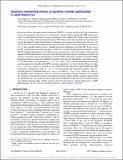Quantum mechanical theory of dynamic nuclear polarization in solid dielectrics
Author(s)
Hu, Kan-Nian; Debelouchina, Galia Tzvetanova; Griffin, Robert Guy; Smith, Albert A.
DownloadHu_JChemPhys_134_125105(2011).pdf (700.0Kb)
PUBLISHER_POLICY
Publisher Policy
Article is made available in accordance with the publisher's policy and may be subject to US copyright law. Please refer to the publisher's site for terms of use.
Terms of use
Metadata
Show full item recordAbstract
Microwave driven dynamic nuclear polarization (DNP) is a process in which the large polarization present in an electron spin reservoir is transferred to nuclei, thereby enhancing NMR signal intensities. In solid dielectrics there are three mechanisms that mediate this transfer—the solid effect (SE), the cross effect (CE), and thermal mixing (TM). Historically these mechanisms have been discussed theoretically using thermodynamic parameters and average spin interactions. However, the SE and the CE can also be modeled quantum mechanically with a system consisting of a small number of spins and the results provide a foundation for the calculations involving TM. In the case of the SE, a single electron–nuclear spin pair is sufficient to explain the polarization mechanism, while the CE requires participation of two electrons and a nuclear spin, and can be used to understand the improved DNP enhancements observed using biradical polarizing agents. Calculations establish the relations among the electron paramagnetic resonance (EPR) and nuclear magnetic resonance (NMR) frequencies and the microwave irradiation frequency that must be satisfied for polarization transfer via the SE or the CE. In particular, if δ, Δ < ω[subscript 0I], where δ and Δ are the homogeneous linewidth and inhomogeneous breadth of the EPR spectrum, respectively, we verify that the SE occurs when ωM = ω[subscript 0S] ± ω[subscript 0I], where ω[subscript M], ω[subscript 0S] and ω[subscript 0I] are, respectively, the microwave, and the EPR and NMR frequencies. Alternatively, when Δ > ω[subscript 0I] > δ, the CE dominates the polarization transfer. This two-electron process is optimized when ω[subscript 0S[subscript 1]]−ω[subscript 0S[subscript 2]] = ω[subscript 0I] and ω[subscript M] ∼ ω[subscript 0S[subscript 1]] or ω[subscript 0S[subscript 2]], where ω[subscript 0S[subscript 1]] and ω[subscript 0S[subscript 2]] are the EPR Larmor frequencies of the two electrons. Using these matching conditions, we calculate the evolution of the density operator from electron Zeeman order to nuclear Zeeman order for both the SE and the CE. The results provide insights into the influence of the microwave irradiation field, the external magnetic field, and the electron−electron and electron−nuclear interactions on DNP enhancements.
Date issued
2011-03Department
Massachusetts Institute of Technology. Department of Chemistry; Francis Bitter Magnet Laboratory (Massachusetts Institute of Technology)Journal
Journal of Chemical Physics
Publisher
American Institute of Physics (AIP)
Citation
Hu, Kan-Nian et al. “Quantum Mechanical Theory of Dynamic Nuclear Polarization in Solid Dielectrics.” The Journal of Chemical Physics 134.12 (2011): 125105. © 2012 American Institute of Physics
Version: Final published version
ISSN
0021-9606
1089-7690